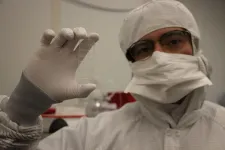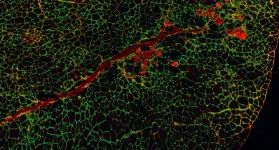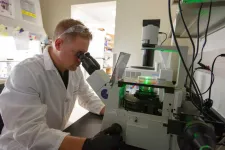Carnegie Mellon/Yale PNA-based technique an essential part of the gene editing toolkit
2021-04-07
(Press-News.org) In an article published in the April 8 issue of Nature, the National Institutes of Health's Somatic Cell Gene Editing Consortium provided a detailed update on the progress of their nationwide effort to develop safer and more effective methods to edit the genomes of disease-relevant somatic cells and reduce the burden of disease caused by genetic changes.
Gene editing allows scientists to modify sections of an organism's DNA and is considered a promising treatment for a number of genetic diseases. There have been numerous advances in the laboratory over the last few decades, but there are still many challenges to overcome before gene editing can be widely used in the patient population. Launched in 2018, the Somatic Cell Gene Editing Consortium (SCGE) has brought together some of the leading researchers in the field to advance discovery and accelerate the translation of somatic gene editing advances in the lab to the clinical setting.
Over six years, the NIH will allocate approximately $190 million to SCGE to realize gene editing's potential. The end result will be a freely available toolkit that will provide the biomedical research community with rigorously evaluated information about genome editors and methods for delivering and tracking gene editing molecules.
"NIH realized it was important for all of us who are investigating gene editing to work together toward a common goal," said Carnegie Mellon University Professor of Chemistry Danith Ly who joined the consortium in 2019. "We're designing molecules that can go into the cell and we're cataloging each and every one. What we'll end up with is a very valuable, rigorously evaluated resource for those who want to bring gene editing to patients."
While much of the consortium's work focuses on CRISPER-Cas related systems, the SCGE points out that it's important to continue to develop other systems. They specifically single out the peptide nucleic acid-based gene editing technique developed by Carnegie Mellon's Ly and Yale University's Peter Glazer.
"Although there is a significant focus on CRISPR-Cas related systems within the SCGE, it is crucial to continue to explore alternate systems, in part because they may differ in both their potential for delivery and their biological or immunological responses," the consortium wrote in Nature.
While CRISPR-Cas edits genes in cells that have been removed from the body, Ly and Glazer's peptide nucleic acid (PNA) system is administered intravenously and edits cells in vivo. Using nanoparticles, a PNA molecule paired with a donor strand of DNA is delivered directly to a malfunctioning gene. Ly, a leading researcher in synthetic nucleic acid technology, has programmed PNA molecules to open double stranded DNA at the site of a targeted mutation. The donor DNA from the complex binds to the cell's faulty DNA and triggers the DNA's innate repair mechanisms to edit the gene. The team has used the technique to cure beta thalassemia in adult mice and in fetal mice in utero.
The PNA gene editing system doesn't have the high-yield of CRISPER-Cas systems, but it does have the advantage of being less likely to make off-target modifications. According to Ly, that means their technique might be better for genetic diseases that only need to have a small percentage of cells corrected to make a therapeutic difference. For example, in the beta thalassemia studies, Ly and Glazer found that editing only six to seven percent of cells was curative.
Ly and Glazer plan to further refine and improve their technique through their participation in SCGE, and they look forward to sharing their results with the consortium and the greater biomedical community.
INFORMATION:
This research is funded by the National Institutes of Health, grant AI145965.
ELSE PRESS RELEASES FROM THIS DATE:
2021-04-07
A natural brilliant blue coloring has been discovered by an international team of researchers including chemists at the University of California, Davis. The new cyan blue, obtained from red cabbage, could be an alternative to synthetic blue food colorings such as the widely used FD&C Blue No. 1. The work is published April 7 in Science Advances.
"Blue colors are really quite rare in nature - a lot of them are really reds and purples," said Pamela Denish, a graduate student working with Professor Justin Siegel at the UC Davis Department of Chemistry and Innovation Institute for Food and Health.
Having ...
2021-04-07
Scientists have developed a long-sought naturally derived cyan blue colorant sourced from red cabbage anthocyanin pigments that may offer an alternative to the industry standard blue dye, although more testing is needed to determine the compound's safety. The novel colorant, which was developed using an enzyme that converts a range of anthocyanins to one with the ideal wavelength, remains highly stable over time and may also produce better green colors than those derived from existing natural blue colorants. Several research programs around the world are dedicated to the hunt for a natural alternative to FD&C Blue No.1 - a challenging effort given that cyan blue is one of the rarest colors in nature. While previous research has shown that ...
2021-04-07
DURHAM, N.C. -- An interdisciplinary team of scientists at Duke University has developed a highly sensitive and rapid diagnostic test for Ebola virus (EBOV) infection. In monkeys infected with Ebola, this diagnostic, called the D4-assay, proved to be 1000 times more sensitive than the currently approved rapid diagnostic test and capable of detecting the virus a full day earlier than the gold standard polymerase chain reaction (PCR) test.
This work, which appears in Science Translational Medicine on April 7, was done by biomedical engineers, molecular ...
2021-04-07
Progression of Duchenne Muscle Dystrophy (DMD) can be delayed in mice by supplementing their diets with Urolithin A, according to new results reported today. The findings, published in Science Translational Medicine, raise hopes that new treatment options could one-day be developed for DMD, an uncurable genetic condition characterized by progressive muscle degeneration. About 1 in 3,500 boys are born with DMD, which usually develops in childhood and significantly reduces life expectancy.
The new research carried out at the laboratory of Professor Johan Auwerx, ...
2021-04-07
The lungs were for a long time considered to be sterile in health, while in diseases like chronic obstructive pulmonary disease (COPD) failure in immune mechanisms were thought to allow microorganisms to proliferate and persist. New sequencing techniques have shown that several microorganisms reside in the lungs of healthy individuals, as well. Few studies have examined the fungal community in COPD and compared it to healthy controls using such techniques. According to the study findings, the compositions of these environments seem to be unaffected by the use of inhaled steroids.
Lungs have a unique fungal environment
The Bergen COPD Microbiome study (short name "MicroCOPD") is the world's largest single-centre study on the fungal community in ...
2021-04-07
JUPITER, FL - People with Crohn's disease are typically treated with powerful anti-inflammatory medications that act throughout their body, not just in their digestive tract, creating the potential for unintended, and often serious, side effects. New research from the lab of Mark Sundrud, PhD, at Scripps Research, Florida suggests a more targeted treatment approach is possible.
Crohn's disease develops from chronic inflammation in the digestive tract, often the small intestine. More than half a million people in the United States live with the disease, which can be debilitating and require repetitive surgeries to remove irreversibly damaged intestinal tissue.
Writing in the journal Nature on April 7, Sundrud's team finds that certain immune cells ...
2021-04-07
Tracking carbon dioxide levels indoors is an inexpensive and powerful way to monitor the risk of people getting COVID-19, according to new research from the Cooperative Institute for Research in Environmental Sciences (CIRES) and the University of Colorado Boulder. In any given indoor environment, when excess CO2 levels double, the risk of transmission also roughly doubles, two scientists reported this week in Environmental Science & Technology Letters.
The chemists relied on a simple fact already put to use by other researchers more than a decade ago: Infectious people exhale ...
2021-04-07
Harmful algal blooms (HABs) occur in all 50 U.S. states and many produce toxins that cause illness or death in humans and commercially important species. However, attempts to place a more exact dollar value on the full range of these impacts often vary widely in their methods and level of detail, which hinders understanding of the scale of their socio-economic effects.
In order to improve and harmonize estimates of HABs impacts nationwide, the National Oceanic and Atmospheric Administration (NOAA) National Center for Coastal Ocean Science (NCCOS) and the U.S. National Office for Harmful Algal Blooms at the Woods Hole Oceanographic Institution (WHOI) convened a workshop led by WHOI Oceanographer ...
2021-04-07
Scientists are testing our fundamental understanding of the universe, and there's much more to discover.
What do touch screens, radiation therapy and shrink wrap have in common? They were all made possible by particle physics research. Discoveries of how the universe works at the smallest scale often lead to huge advances in technology we use every day.
Scientists from the U.S. Department of Energy's (DOE) Argonne National Laboratory and Fermi National Accelerator Laboratory, along with collaborators from 46 other institutions and seven countries, are conducting an experiment to put our current understanding of the universe to the test. The first result points to the existence of undiscovered particles or forces. This new physics could help explain long-standing ...
2021-04-07
AMHERST Mass. - The long-awaited first results from the Muon g-2 experiment at the U.S. Department of Energy's Fermi National Accelerator Laboratory show fundamental particles called muons behaving in a way that is not predicted by scientists' best theory, the Standard Model of particle physics. This landmark result, made with unprecedented precision and to which UMass Amherst's David Kawall's research group made key contributions, confirms a discrepancy that has been gnawing at researchers for decades.
"Today is an extraordinary day, long awaited ...
LAST 30 PRESS RELEASES:
[Press-News.org] Carnegie Mellon/Yale PNA-based technique an essential part of the gene editing toolkit






